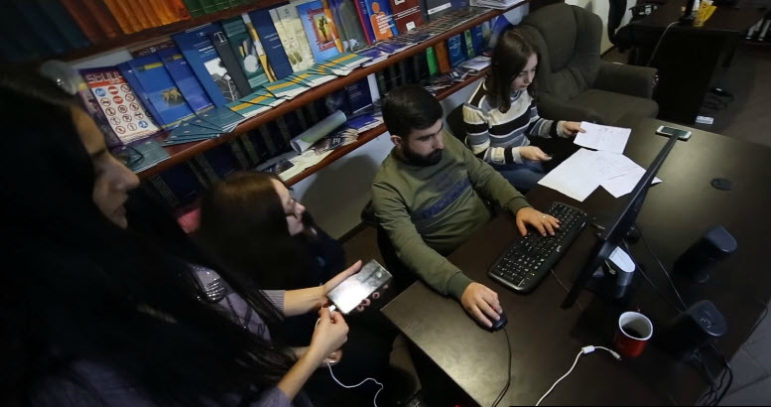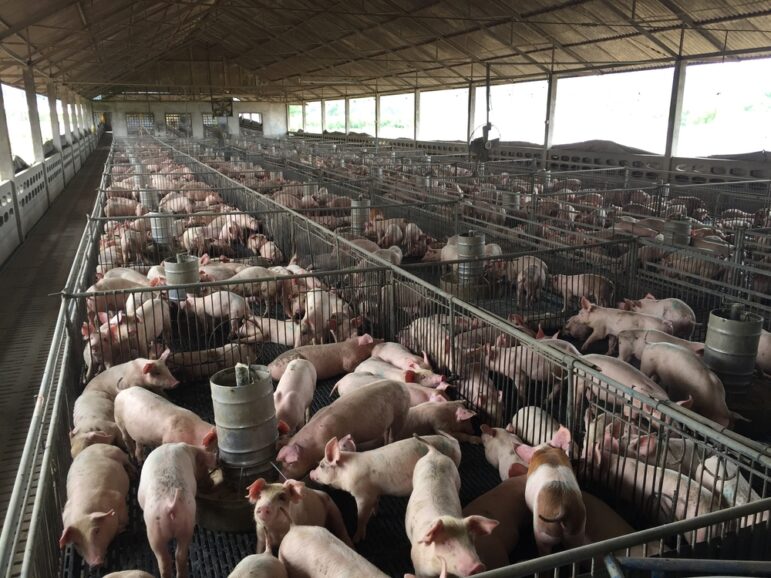

Students at Valeri Brusov University edit their report at the studio of Armenia's nonprofit Shabat.am, for the first season of the show.
‘Reality Journalism’ Turns Investigative Reports into Pop Idol-Style Shows

Competing student teams discuss their stories on Armenian public television. Photo: Courtesy EJC
Around the world, millions of people seem to be tuning serious journalism out, as the fallout from misinformation, fatigue, and rival information sources overwhelm audience attention. But in three developing countries, new audiences are tuning in to watch investigative reporting teams compete in pop idol-style reality shows.
In a new approach supported by the European Journalism Centre (EJC), journalism and communications university students in Kenya, Bolivia, and Armenia are pursuing real-world, short-form investigative stories that are “judged” by both professionals and the public on national TV shows.
In Kenya, surveys show that about 4 million people watched the Top Story reality journalism show each week, while tens of thousands have viewed the Journalistic Battles series on the YouTube channel of Armenian public television.
A recent EJC survey showed a direct link between this “reality journalism” and increased media literacy in Kenya, with 78% of Kenyan viewers indicating a greater understanding of how reporters work, and 67% saying they better understood the role of investigative journalism.
But the model has also faced some early criticism as a showcase for the investigative craft.
Critics and the show’s own jurors have labeled some of the reporting as “shallow.” While Journalistic Battles’ stories have triggered some real-world impacts – like the firing of a corrupt hospital official – its creator, Karen Andreasyan, conceded that student teams rely on interviews, and have yet to unearth documentary evidence of wrongdoing.
The shows have also faced some challenging headwinds. Three students from Armenia’s Gyumri State University were interrogated by police and threatened with criminal charges for refusing to name their source, before media lawyers stopped the harassment, Andreasyan said. Meanwhile in Kenya, Top Story had to switch to a commercial TV partner after a public broadcaster tried to censor a story, and student teams often require security escorts due to safety concerns.
Yet Josh LaPorte, the media development lead at EJC, points out that the shows have achieved a measurable impact on media literacy and enthusiasm for investigative stories in all three markets.
“These shows have had a remarkably positive impact for students, audiences, and university curricula to some extent,” said LaPorte. “Our survey showed that more viewers are understanding that investigative journalism is not just a bunch of people writing up gossip; that it does support accountability, it does fight corruption.”
In Armenia, viewers responded with outrage on social media after watching student contestants show how rich families had exploited public spaces in Yerevan to develop luxury villas. Andreasyan said their short documentary amplified an “excellent” long-form report by Armenia’s investigative nonprofit Hetq online, which had seen a much smaller response. Another student team exposed alleged corruption in a local milk cooperative.
In Kenya, NTV viewers watched as students dressed in biohazard suits highlighted the illicit trade in donkey meat.

Students at Valeri Brusov University edit their report at the studio of Armenia’s nonprofit Shabat.am, for the first season of the show. Photo: Courtesy EJC
Juggling Apples
The shows are dramatic, with teams seen reacting to judges’ remarks that their stories have either won or been “killed.” Footage of the reporting is edited to emphasize the most exciting moments – such as the Armenian student who is filmed in a car telling someone on the phone, “Some unknown people are following us!”
LaPorte said, “Our jurors and our trainers are quite up-front with their own concerns about the format: ‘Is it turning serious work into entertainment?’ Well, on all the promos for Top Story, you always see somebody crying. But the serious issues and the meat of the show — the journalism — does shine through. I don’t think anyone is pushing the envelope too far, and I trust that our partners know local conditions better than we do.”
The origins of the model can be traced to a pile of apples in Andreasyan’s media law class at Yerevan State University in 2007. A human rights lawyer, Andreasyan found that dozing or uninterested students became engaged with important legal principles when he juggled apples, with each piece of fruit representing concepts like privacy, libel, and defamation. He had the students compete for small prizes to win their interest.
“As a professor … I found that I was happy to juggle apples to get attention on important information,” he said. “I think societies are getting more superficial; that bringing them serious content in a serious format simply will not be interesting for much of the public. Therefore, I thought we can accommodate the interests of society by making serious and important stuff a bit more entertaining and transparent.”
Initially, Andreasyan invited student teams from 10 Armenian university programs to compete with one another on mock stories.
“It was just a competition between journalism schools, where we would get real people – doctors, bartenders – and create mock stories about them,” he said. “In Armenia, we had 18 universities teaching journalism, but the quality was very low, very academic. We were trying to change the curricula of the universities by making them feel competitive with each other.”
The EJC supported the initiative, and replicated the project with Bolivian universities in 2012 – even though universities there offered communications programs, rather than dedicated journalism courses. Soon after, reality journalism nonprofits in both Bolivia and Kenya were supported with seed funding from the Dutch government.
While the model has evolved from mock stories to real stories, and from text submissions to TV events, the common feature throughout has been training-oriented mentorship and judging by professional senior journalists, according to Andreasyan. The jury for Journalistic Battles, for instance, has included former Reuters New York bureau chief Lisa Essex; Vahagn Tevosyan, former head of news for Armenia’s national broadcaster; and Shushan Doydoyan, president of Armenia’s Freedom of Information Center.
“Experienced journalists give the teams scores with points for media ethics, for fact-finding, and for presentation,” said Andreasyan. “But beyond the points, the more important feature is that these professional juries give a lot of feedback, so the audience and the students really learn about how quality stories should be produced.”
LaPorte said the shift from mock stories to real stories was difficult. The shift from offline to TV, he said, was surprisingly easy.
“There was a lot of discussion about going from mock stories to real stories, especially regarding the safety of students,” he said. “Karen and I would write these mock scenarios – on poaching in Kenya, on human trafficking in Bolivia; pretty dramatic stories. We were nervous because sending students out there to cover real stories, even of local corruption, involves the schools, permissions from parents, even legal considerations. We didn’t go into this wanting 21-year-olds to try to bring down governments; we just wanted to get them real-world experience, and get universities to upgrade their curricula.
“But when we started filming mock stories, we found there was something missing. We came to realize that if we frame the stories properly, with just enough of an edge, but not putting students directly in harm’s way, then real stories made it work.”

Anna Ghazaryan, a finalist from Season 1 of Journalistic Battles, interviews civic activist Vardges Gaspari on corruption in prisons. Photo: Courtesy EJC
Doing it Differently
LaPorte said EJC’s Kenyan partner Joseph Warungu, the former head of the BBC African News department, drove the switch to a TV format in 2015. Now, small nonprofit organizations in all three countries produce the shows, which typically involve 25-minute episodes in four- or five-month seasons. The EJC — which has facilitated five-year grants in Kenya and Bolivia from European donors — also provided funding for the non-televised portion of Armenia’s project and continues to provide expertise.
“Each country does it differently,” said LaPorte. “Bolivia pretapes everything. Kenya does a boot camp, where all the teams gather for a week and there’s a process of elimination. Then they film the judging slowly over two or three months. Armenia’s show used to be on YouTube and Facebook, and is now broadcast on public TV.”
John Wihbey, a media literacy expert who is head of graduate programs at the Northeastern University School of Journalism, said there was merit to concerns that the model’s entertainment element could confuse some audiences about the accountability function of public service journalism. However, Wihbey said this was mitigated by the model’s documentary-style transparency and outweighed by its benefits.
“Of course, putting journalism in the show-biz style format of reality television can seem to trivialize the serious endeavor of investigative journalism,” he said. “But that potential negative dimension is, to my mind, outweighed by the possibility of greater community engagement. It makes investigative journalism more attractive and engaging to both practitioners and audiences. I like the emphasis on showing the journalistic process at work, as publics across the world often fail to understand how we journalists verify evidence, arrive at conclusions, and create stories.”
Wihbey said carefully produced reality journalism shows would likely work well in developed countries and could help improve media literacy for distracted societies.
Andreasyan said he’d love to test this kind of program in the west.
“Many people are skeptical about journalists here, after some took money from oligarchs,” he said. “For instance, one viewer wrote that she had thought that investigative reporters ‘just spoil the lives of people.’ Journalists are otherwise seen like academics – not directly relevant to people’s lives. These shows are really changing those perceptions.”
 Rowan Philp is a multiple award-winning journalist who has worked in more than two dozen countries. Currently based in Boston, Philp was the chief reporter and London bureau chief for South Africa’s Sunday Times for 15 years.
Rowan Philp is a multiple award-winning journalist who has worked in more than two dozen countries. Currently based in Boston, Philp was the chief reporter and London bureau chief for South Africa’s Sunday Times for 15 years.









